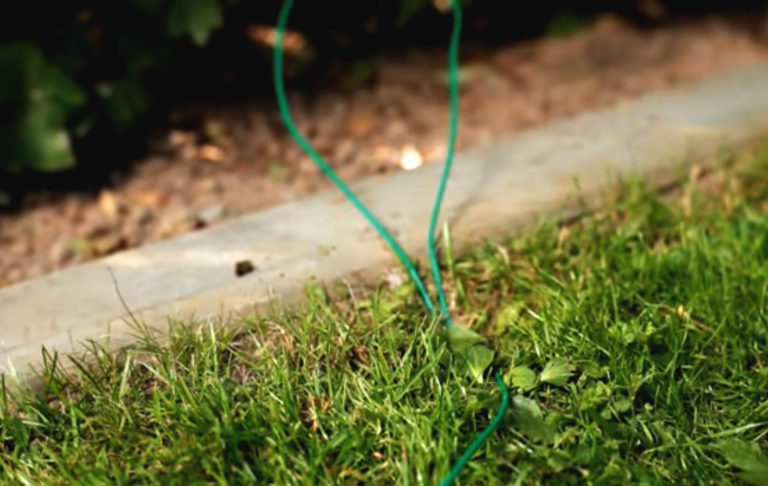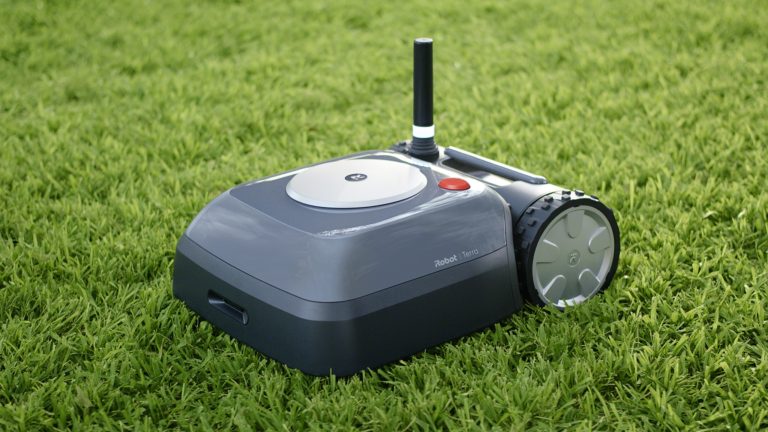Laying the perimeter wire of your mowing robot can be a real pain. However, during my research on this problem I have discovered a number of useful tools that can make it much easier for you to lay the boundary wire. Here is my list of the most useful tools for laying boundary wire.
Contents
1. You Can Use the Turbo Run of an Angle Grinder to Slash the Ground Open
If you want to lay the cable underground, you can use a flex for this. This works really well and is very fast. You can mark the route beforehand, for example with garden chalk or a tightly pulled string. Then you start slashing the ground open. The small created gap in the ground has exactly the right width for the cable. The depth of course depends on the angle grinder. The bigger the angle grinder, the deeper you get into the ground. For many mowing robots, the cable may go up to 4 inch deep into the ground, some even up to 7 inch.
In this video you can see an example of how someone works the ground with an angle grinder (Video is in German, but you can easily see how it works). I will come back to the other product shown in the video in a moment.
2. A Chain Saw Can Provide an Alternative to an Angle Grinder
Yeah, you heard right. Even with a chainsaw you can get the work done. But it’s best to use an old chain. If you don’t have an old chain, you can of course just use the one you have available. But be aware that you will not be able to use the chain for sawing wood afterwards. A new chain usually costs around 20 Dollars.
The advantage of the chain saw is that you can make deeper and wider gaps if you want to lay the cable a bit deeper or if you have a thicker cable – the thickness of the cable can vary depending on whether it has special protective coverings or not and is also influenced by the maximum area output of your robot lawn mower.
3. A Circular Handsaw Serves as Another Good Alternative
The job can also be done with an old circular handsaw. You can get through the grass much faster than with a spade or lawn edger. Again, use an old tool or an old saw blade with which you no longer want to saw wood.
Some circular saws have a spacer, which can also be extremely useful here. As with flex and chain saws, it is best to mark the distance you want to “saw” in advance.
4. A Laying Rod Is Used to Sink the Cable
The device I am now presenting is so new and innovative that it doesn’t seem to have a name yet. I call it “Laying Rod” because it reminds me a bit of a fishing rod. I also haven’t seen yet that you can buy it anywhere. But it’s quite easy to make something like this yourself.
The device is used to lay the cable underground in the gap you created in the lawn. It is simply a wooden stick or handle, which is about 3 feet long. At the tip of the rod there is a tube attached, which is bent like a nose.
Into this tube you thread the cable so that it runs in at the top of the “bridge of the nose” and runs out again at the bottom. The lower side is led through the gap in the lawn. The advantage of this construction is that the cable is always taut and is led through the gap at the same height, so you don’t have any unevenness in the course of the cable.
To give you a better idea of the whole thing, here is a video:
5. The Laying Aid Roll for Cable Laying and Countersinking
This device actually looks even more like a fishing rod. It is simply called “installation aid” and is used to make it easier to lay the cable.
It is a long rod with a roll at the bottom end, which you can use to guide the rod over the ground to lay the cable. The roller can be replaced depending on whether you want to lay it above or below ground. For the latter, there is a larger roller so that you can drive through the gap with the device.
There is also a spacer at the bottom of the rod so that you can take the correct distance into account while unrolling the cable. Of course, this only helps you when laying the cable above ground, otherwise you should already have created the gap.
At the other end, above the handle, there is a hook into which you can hook the cable reel. With this reel, the device actually resembles a fishing rod.
I have only found the device on Amazon.de yet. Hopefully it will also be available on Amazon.com in the future.
Also included is a special rod with which you can put the stakes into the ground without having to bend down. In general, the whole construction is designed to avoid having to bend down when laying the cable.
However, if you want to lay the cable underground, you still have to make a gap beforehand, with a spade, lawn edger or one of the methods mentioned above using an angle grinder, a chainsaw or a circular handsaw. Some buyers of this product were a bit confused that you can’t cut the lawn with it, so I mention it here again.
Here you can see the device in action. This is the same video showing the use of the angle grinder above:
6. A Dead Blow Soft-Head Hammer Prevents Damage to the Cable
Use a dead blow soft-face hammer for hammering in the fastening stakes. Yes, you probably have a hammer in your toolbox and you can use it if necessary. The problem with metal hammers is that they can damage the cable with their sharp edges when fixing the stakes.
If the cable has even the tiniest damage, moisture can penetrate over a long period of time. This causes the cable to oxidize, so it will rust, and eventually rust through, resulting in a broken cable and the laborious work of locating the cable break.
It is better to use a wooden hammer, or even better a rubber hammer. Maybe you have something suitable.
But if you can’t find something suitable, I can only recommend this special blow-back proof soft-face hammer. Due to its plastic coating it does not scratch or crack the “hammered” material. It has a filling on the inside, which absorbs the recoil that occurs during hammering. This is easy on the wrists, but at the same time allows for safer working (the hammer does not bounce so easily).
Such a hammer can also be used in many other areas, whenever you want to hammer somewhere without causing damage through scratches or cracks (furniture, car, etc.).
If you are looking to buy such a tool, I have found a really good one here on Amazon. Do not be shocked by the price. This is not just “a” hammer, it is a professional tool used by professionals. If all you want to do is fastening the stakes, that might be an overkill. Then a simple rubber mallet is probably the right choice. It doesn’t have the special filling in it that keeps the former hammer from bouncing, but has a rubber cover that prevents the cable from taking any damage.
7. With Cable Laying Machines the Laying of the Loop Cable Is Very Fast
This kind of machine is often used by professionals to lay the cable. It is extremely useful for laying the cable, but also extremely expensive. It is certainly not worthwhile for you to buy such a machine, as it will most likely cost more than your mowing robot.
Or at least about the same amount if you have one of the more expensive Automowers. I have seen very cheap models for around 400 Dollars, but most of them cost between 2000 and 4000 Dollars. You should rather borrow one.
The cable laying machine is a machine that runs on two large rigid wheels and a small moving wheel and is guided by a handle. A petrol or electric motor drives a circular saw-like metal disc that can cut into the turf and the ground.
Cable laying machines are also available for hire. You can either rent such a machine for a small fee, e.g. in a DIY store, or you can rent it from various specialist dealers. Perhaps the dealer from whom you want to buy your mowing robot offers such a machine directly.
There are also various rental offers on the Internet. Sometimes you can be lucky if you browse one of the many classifieds websites.
The following video shows how to work with the machine:
8. Joint Scraper for Laying the Cable Near the Surface
Very spartan and simple. If you don’t want to make a big effort and just want to lay the cable above ground, you can at least make a slight crack in the sod with a joint scraper into which you can sink the cable a little. The rest will then simply grow into the lawn.
Laying the cable above ground has the advantage that you can easily make corrections if you want to lay the cable differently in a place that the mowing robot does not mow properly. You can also lay it above ground at the beginning and then sink it into the ground at some point. It is best to do this after no more than 4 weeks, because by then the cable is already relatively well grown in, which makes it more difficult to sink the cable.
Many mowing robot owners, even experts in the field, do not lay their cable underground. It works that way, too. However, if you scarify your garden, there is a greater risk that the cable will be damaged. You must then always be careful not to cut the cable.
9. A Large Pizza Roller Can Cut a Few Inch Deep
No joke, some people use a particularly large pizza wheel (with which one actually cuts pizza) to pull a, of course not particularly deep, crack through the lawn. I have only read about it and have neither tried it myself nor seen it live.
But I found a video here, where someone does something similar, with two different sized “pizza wheels”, if you will.
10. A Cordless Lawn Edge Trimmer Can Quickly Create a Gutter Around the Garden
Some battery powered lawn trimmers also come along with a functionality that enables you to create a gutter around the garden. Surely you are familiar with such trimmers, that allow you to mow the edge of your lawn even if your mowing robot has not quite reached the edge, for example. You can also mow low bushes and the like with it.
With some trimmers, the head can be turned so that it does not cut horizontally to the ground, but vertically. This allows you to drive along the edge of your garden and cut a small gap in the ground.
An example of a suitable lawn edge trimmer is this one on Amazon. Take a look at the product images there, then you know what I mean. The head of the lawn trimmer is turned to the side and the rotor blades literally chop into the ground. This is an intended use of the machine. This particular product even has the option to switch between different blades. I wouldn’t use the saw disc though.
Of course, the gap you can produce with this is not nearly as big and deep as when you use a chainsaw, but it is enough to sink the cable in some depth.
Make sure that you buy a device with plastic blades or anything else other than strings. Many lawn edge trimmers use strings instead of blades, but they cannot cut into the ground.
These were my 10 useful tools for laying your boundary wire. I hope there was something useful for you.






Hi Matthias, thanks very much for your helpful article which was just what I was looking for. I am thinking of getting one or more robot mowers to mow my lawns and a small paddock here in the UK – I am having to revise how things are done here because I have over a short time gone from being well to seriously ill. I wish you the best and I thank you for your contributions to public knowledge. Also may I say that I never wanted the UK to leave the EU – it ws a stupid move which has weakened the UK, the EU, and even the West.
Best regards,
Jon
Hi Matthias,
I thought I should ley you know: I just found your mower recommendations pages but the links seem to be missing. I’m using lastest FireFox on Windows7.
Kind regards,
Jon
Hi. Thanks for this really interesting article.
Can you tell me exactly what type of blade you used in the angle grinder (in section 1), please?
Vielen Dank.